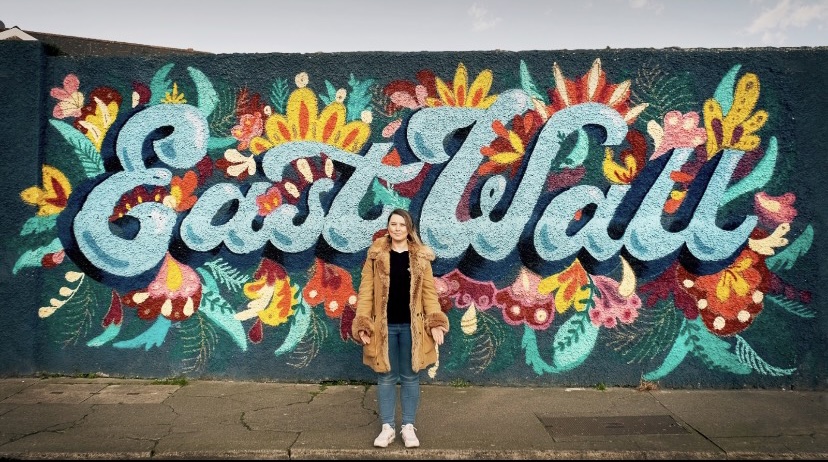
Our beloved Irish language, which once filtered through the air as the country’s primary vernacular, has had to contend with many an adversity over the years. Unfortunately, many today know it simply as a poorly-taught school subject, or as Roxanna Nic Liam puts it from a Dubliner’s perspective: the unrelatable language of “idyllic green fields and Bean An Tí’s and Peig Sayers”.
However, the language still holds a strong presence across the island. This was made plain earlier this week when Axis Ballymun launched Scríobh, a new digital Irish language theatre festival.
The festival began online on Monday evening with a short film entitled “Siúcra”, written and performed by actor and spoken word artist Roxanna Nic Liam. The film is an exploration of identity within the Irish language, following Nic Liam as she passionately meanders through the streets of Dublin and the wonders of the tongue.
One of the short film’s central themes is the seanfhocal (an old Irish saying that encompasses years of wisdom and wit). “An rud is annamh is iontach” is one such saying that Nic Liam imparts throughout the film: “The thing that’s seldom is wonderful”. Sitting with a cup of tea, she begins the film by opening a packet of sugar (or siúcra) with a seanfhocal written on it, before delving into the deep history and sentiments behind these wise old sayings.
In conversation with The University Times, Nic Liam provides a deeper insight into the idea of the film and her personal connection to it. Commissioned by Axis Ballymun to write a bilingual poem about the Irish language, she began the project by reflecting upon Irish “as an entity”, and her relationship with it. This led to explorations of both the positive and negative associations with the language.
For example, the film raises the issue of gatekeeping: how those with a more basic level of Irish often refrain from speaking it due to a fear of making mistakes. “It’s so intertwined with shame that it can put people off from even trying”, Nic Liam explains. The film contradicts this sentiment, however, encouraging the use of whatever Irish people have “for safekeeping, not for gatekeeping”.
Keeping this in mind, Nic Liam speaks to me about her interest in “the idea of identity within the language – especially outside of Gaeltachts”, an identity she has personally struggled with. In “Siúcra”, through her distinct Dublin dialect, she poses the question: “cé hí mise? [translation: who am I?]”. With this question, she explores how she can simultaneously ground herself in both her ancient roots, and the modern Irish present.
Nic Liam is passionate about this idea of celebrating the history and modernity of the language together: “People talk about [Irish] as a mystical, ancient language, which of course, it is. But it’s also a modern, functional language that people use in their every-day life.”
Fitting with these sentiments, the film is set against the backdrop of today’s inner-city Dublin. Nic Liam is from East Wall, and wanted to film the piece in and around the city centre where she grew up, as she believes that the Irish language “belongs just as much to anyone who grew up in Dublin City, Cork City, Derry or Belfast”.
“My walk to my school every morning was grey concrete – there were no forty shades of green to be seen”, she illustrates. With videographer Cathal Mac An Bheatha, she “wanted to try and show that dichotomy”, she explains, through contrasting shots of an urbanised city with others filmed among nature.
It’s against these backdrops that Nic Liam takes her audience’s virtual hand and walks us through some of the wonders of Irish. “You can’t translate everything as Gaeilge” she points out in the film, referring to the language’s distinctly original ways of phrasing and communicating meaning such as having multiple Irish words for one English word. Given that there are 12 different ways to say “mysterious” as Gaeilge, it seems our ancestors certainly possessed a magical disposition for describing the world around us.
They also embodied a fantastic sense of humour, although, we could have assumed that. If you’re looking to describe an attractive yet useless man, well, that’s an “áilleanach”, we’re told in the short film. And a small, cute person is a “drúchtíneach” – I could go on.
“Magical” is a word Nic Liam mentions regularly. Is there any other term to describe the Irish language so aptly? Well, as Gaeilge, there are probably 12 of them. I, for one, certainly concluded my watching “Siúcra” with a sweet taste in my mouth, and a yearning to reignite my relationship with my native tongue.
“Siúcra” can be viewed free of charge on axisballymun.ie.






